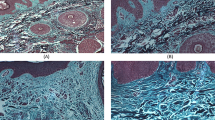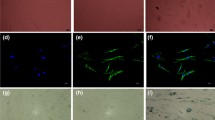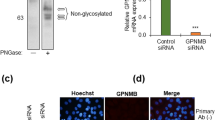Abstract
Recently, multiple culprits—in addition to melanocytes—have been implicated in the pathogenesis of vitiligo. Among those factors are fibroblasts. However, their exact role has not been clearly elucidated. The aim of the study was to evaluate the possible role played by fibroblasts in vitiligo via studying the expression Tenascin C and DKK1 in acral versus non-acral vitiligo lesions. This case–control study included 19 non-segmental vitiligo patients and ten controls. All patients were subjected to thorough clinical evaluation. Both Tenascin C and DKK1 were measured in lesional and peri-lesional skin of acral and non-acral lesions using ELISA technique. The measured levels of Tenascin C and DKK1 were significantly higher in the vitiligo group when compared to controls in all assessed sites (P < 0.05). Tenascin C was found to be significantly higher in lesional areas compared to peri-lesional ones only in the acral sites. DKK1 was significantly higher in lesional areas in all assessed sites (P < 0.05). The current work suggests a malfunction of fibroblasts in vitiligo, through demonstrating significant up-regulation of two melanogenesis inhibitory products (Tenascin C and DKK1) in patients compared to controls. Larger scale studies are warranted to detect the possible implications of such findings on vitiligo treatment.

Similar content being viewed by others
References
Abdou AG, Maraee AH, Shoeib MA, Elbana R (2012) Immunolocalization of tenascin-C in vitiligo. Appl Immunohistochem Mol Morphol 20(5):501–511
Begum R, Marfatia YS, Laddha NC, Dwivedi M, Singh M (2014)) Vitiligo: a complex disease and a complex approach. Mol Cytogen 7:1–157
Buffey JA, Messenger AG, Taylor M, Ashcroft AT, Westgate GE, MacNeil S (1994) Extracellular matrix derived from hair and skin fibroblasts stimulates human skin melanocyte tyrosinase activity. Br J Dermatol 131(6):836–842
Cario-André M, Pain C, Gauthier Y, Casoli V, Taieb A (2006) In vivo and in vitro evidence of dermal fibroblasts influence on human epidermal pigmentation. Pigment Cell Res 19(5):434–442
Chiquet-Ehrismann R, Kalla P, Pearson CA et al (1988) Tenascin interferes with fibronectin action. Cell 53:383–390
Duval C, Cohen C, Chagnoleau C, Flouret V, Bourreau E, Bernerd F (2014) Key regulatory role of dermal fibroblasts in pigmentation as demonstrated using a reconstructed skin model: impact of photo-aging. PLoS One 9:e114182
Esmat SM, El-Tawdy AM, Hafez GA, Zeid OA, Abdel Halim DM, Saleh MA, Leheta TM, Elmofty M (2012) Acral lesions of vitiligo: why are they resistant to photochemotherapy? J Eur Acad Dermatol Venereol 26(9):1097–1104
Gauthier Y, Cario Andre M, Taïeb A (2003) A critical appraisal of vitiligo etiologic theories. Is melanocyte loss a melanocytorrhagy? Pigment Cell Res 16(4):322–332
Gulcher JR, Nies DE, Alexakos MJ, Ravikant NA, Sturgill ME, Marton LS, Stefansson K (1991) Structure of the human hexabrachion (tenascin) gene. Proc Natl Acad Sci USA 88(21):9438–9442
Hautmann G, Moretti S, Lotti T, Hercogova` J (2004) Pathogenesis of vitiligo: evidence for a possible ongoing disorder of the cutaneous microenvironment. In: Lotti T, Hercogova` J (eds) Vitiligo: new data and hypotheses. Marcel-Dekker, New York, pp 99–121
Hegazy RA, Fawzy MM, Gawdat HI, Samir N, Rashed LA (2014) T helper 17 and Tregs: a novel proposed mechanism for NB-UVB in vitiligo. Exp Dermatol 23(4):283–286
Imokawa G (2004) Autocrine and paracrine regulation of melanocytes in human skin and in pigmentary disorders. Pigment Cell Res 17(2):96–110
Kim YC, Kim YJ, Kang HY et al (2008) Histopathologic features invitiligo. Am J Dermatopathol 30:112–116
Kumar R, Parsad D, Kanwar AJ, Kaul D (2011) Altered levels of Ets-1 transcription factor and matrix metalloproteinases in melanocytes from patients with vitiligo. Br J Dermatol 165(2):285–291
Le Poole IC, van den Wijngaard RM, Westerhof W, Das PK (1997) Tenascin is overexpressed in vitiligo lesional skin and inhibits melanocyte adhesion. Br J Dermatol 137(2):171–178
Marionnet C, Pierrard C, Vioux-Chagnoleau C, Sok J, Asselineau D, Bernerd F (2006) Interactions between fibroblasts and keratinocytes in morphogenesis of dermal- epidermal junction in a model of reconstructed skin. J Invest Dermatol 126:971–979
Midwood K, Sacre S, Piccinini AM et al (2009)) Tenascin-C is an endogenous activator of toll-like receptor 4 that is essential for maintaining inflammation in arthritic joint disease. Nat Med 15:774–780
Midwood K, Orend G (2009) The role of tenascin-C in tissue injury and tumorigenesis. J Cell Commun Signal 3(3–4):287–310
Moretti S, Fabbri P, Baroni G, Berti S, Bani D, Berti E, Nassini R, Lotti T, Massi D (2009) Keratinocyte dysfunction in vitiligo epidermis: cytokine microenvironment and correlation to keratinocyte apoptosis. Histol Histopathol 24(7):849–857
Oh SH, Kim JY, Kim MR, Do JE, Shin JY, Hann SK (2012) DKK1 is highly expressed in the dermis of vitiligo lesion: is there association between DKK1 and vitiligo? J Dermatol Sci 66(2):163–165
Pesheva P, Probstmeier R, Skubitz AP, McCarthy JB, Furcht LT, Schachner M (1994) Tenascin-R (J1 160/180 inhibits fibronectin-mediated cell adhesion–functional relatedness to tenascin-C. J Cell Sci 107:2323–2333
Schirmer C, Klein C, von Bergen M, Simon JC, Saalbach A (2010) Human fibroblasts support the expansion of IL-17-producing T cells via up-regulation of IL-23 production by dendritic cells. Blood 116(10):1715–1725
Taïeb A, Morice-Picard F, Jouary T, Ezzedine K, Cario-André M, Gauthier Y (2008) Segmental vitiligo as the possible expression of cutaneous somatic mosaicism: implications for common non-segmental vitiligo. Pigment Cell Melanoma Res 21(6):646–652
Yamaguchi Y, Morita A, Maeda A, Hearing VJ (2009) Regulation of skin pigmentation and thickness by Dickkopf 1 (DKK1). J Investig Dermatol Symp Proc 14(1):73–75
Yamaguchi Y, Passeron T, Hoashi T, Watabe H, Rouzaud F, Yasumoto K, Hara T, Tohyama C, Katayama I, Miki T, Hearing VJ (2008) Dickkopf 1 (DKK1) regulates skin pigmentation and thickness by affecting Wnt/beta-catenin signaling in keratinocytes. FASEB J 22(4):1009–1020
Author information
Authors and Affiliations
Corresponding author
Ethics declarations
Conflict of interest
The authors declare that they have no conflict of interest.
Funding
There is no funding source.
Ethical approval
This article contains studies with human participants.
Informed consent
Informed consent was obtained from all individual participants included in the study.
Rights and permissions
About this article
Cite this article
Esmat, S.M., Hadidi, H.H.E., Hegazy, R.A. et al. Increased tenascin C and DKK1 in vitiligo: possible role of fibroblasts in acral and non-acral disease. Arch Dermatol Res 310, 425–430 (2018). https://doi.org/10.1007/s00403-018-1830-z
Received:
Revised:
Accepted:
Published:
Issue Date:
DOI: https://doi.org/10.1007/s00403-018-1830-z




